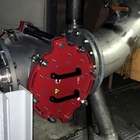Chute magnets ML-P for vacuum and pressure pipes
ute magnet ML-P for pressure pipes is designed to separate ferromagnetic particles especially from quickly streaming (up to 25 m/s) liquids (but also powders) of worse pouring properties. Compared with e. g. grid separators, the ML-P is suitable also for liquids containing bigger pieces of materials, fibers or abrasive particles.
Design of plate magnetic separator
The separator housing (made from stainless steel) is to be connected to a pipeline (by means of standard flanges) in order to become its integral part. At the separator inlet there is a solid steel baffle that directs the material flow over the magnetic plates (placed at the inner parts of the separator doors) and ensures a high effectiveness of the separation process (nevertheless, the material divider is dismountable - therefore, in the case of cleaning very problematic materials, it can be easily taken out of the separator).
Which way is plate magnetic separator cleaned?
In the course of the separator cleaning (after stopping the material flow), the magnetic door is pulled out first and then turned. Subsequently the accumulated ferromagnetic contaminants can be wiped off from the inner door side (and, if needed, rinsed with power water). Thanks to the door emplacement on guiding rods, the manipulation with magnetic cores during the cleaning process is easy and user friendly (even in case of bigger separators).
What pipeline is the separtor connected to?
In the standard way the deep field housed magnet ML-P is produced in connecting diameters from 100 to 250 mm with pressure resistance up to 10 bar. Nevertheless, the pressure resistance, connecting dimensions and also the way of connection onto the piping system (flanges, screwed fittings etc.) can be modified according to the customer’s needs.
Which industrial branches can the plate magnetic separator be use of in?
The pipeline magnet ML-P can be characterized by a robust stainless steel construction, a big separation efficiency (thanks to the neodymium magnets), a high-capacity (no undesirable obstacles prevent the material flow in the inside of the separator body) and by an easy maintenance. The separator finds its use especially in the pulp and paper industry, because it can even deal with bridging and choking materials (like the longer fibers that are usually present in materials processed in the paper industry). On the contrary, with regard to a relatively big distance between the magnetic doors, the separator is not suitable for cleaning the materials requiring an extreme purity, e.g. in the food industry.

Plastikářský a gumárernský průmysl

Automobilový průmysl

Chemický průmysl, nátěrové hmoty

Keramický a sklářský průmysl

Tepelné elektrárny

Strojírenský a slévárenský průmysl

Papírenský průmysl
How does plate magnetic separator work?
Through the magnetic field, the caught iron contaminants are retained during the separative process on the inside of the magnetic door. To achieve the most effective separation of magnetic particles, this chute magnet is fitted with extra strong neodymium (NdFeB) magnets (therefore, the induction up to 9,000 Gauss can be reached in the area of contact with the flowing material).
ML-P
The pipe magnet ML-P is designed to separate ferromagnetic particles especially from quickly streaming (up to 25 m/s) liquids (but also powders) of worse pouring properties.
| Product | Input/output diameter (mm) | Datasheet (CZ) |
|---|---|---|
| ML-P 100 N | 100 | display PDF |
| ML-P 150 N | 150 | display PDF |
| ML-P 200 N | 200 | display PDF |
| ML-P 250 N | 250 | display PDF |





